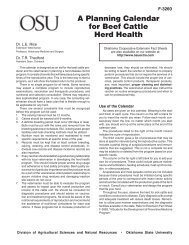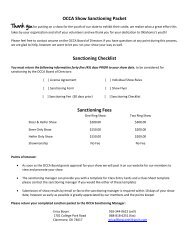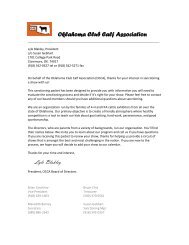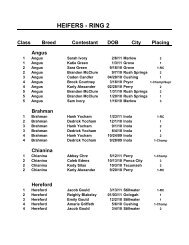Basics About Beef - the Oklahoma Club Calf Association
Basics About Beef - the Oklahoma Club Calf Association
Basics About Beef - the Oklahoma Club Calf Association
You also want an ePaper? Increase the reach of your titles
YUMPU automatically turns print PDFs into web optimized ePapers that Google loves.
TENDERIZING<br />
20 You may choose to tenderize less<br />
tender cuts of beef before cooking <strong>the</strong>m.<br />
They can <strong>the</strong>n be cooked by a dry heat<br />
method. You can use marinades,<br />
pound or cube <strong>the</strong> meat or use commercial<br />
tenderizing mixtures.<br />
MARINADES<br />
Marinades are seasoned liquid mixtures<br />
that add flavor and in some cases tenderize.<br />
A tenderizing marinade must contain an<br />
acidic ingredient or a natural tenderizing<br />
enzyme. Acidic ingredients include<br />
vinegar, wine, and citrus or tomato<br />
juice. Naturally tenderizing<br />
enzymes are found in fresh<br />
papaya, ginger, pineapple and<br />
figs. The food acid or enzyme<br />
helps soften or break down <strong>the</strong><br />
meat fibers and connective tissue<br />
and adds flavor. Some marinades<br />
also contain a small amount<br />
of oil. Marinades penetrate only<br />
about 1 /4 inch into <strong>the</strong> surface of <strong>the</strong><br />
meat, so <strong>the</strong>y work best on thinner cuts.<br />
When marinating, containers must be covered.<br />
If <strong>the</strong> marinade has been in contact with uncooked<br />
meat, it must be brought to a rolling boil for one<br />
minute before adding it to cooked meat.<br />
However, it is better to set aside a portion of<br />
<strong>the</strong> marinade mixture to use later as a sauce<br />
for basting. Be sure that it hasn’t come in<br />
contact with raw meat.<br />
POUNDING<br />
Pounding with a heavy object such as a<br />
meat mallet tenderizes by breaking down <strong>the</strong><br />
connective tissue.<br />
CUBING<br />
Cubing is a more thorough process than pounding<br />
because it breaks down <strong>the</strong> fiber structure even more.<br />
<strong>Beef</strong> is “cubed” by a machine.<br />
Do not confuse this with<br />
grinding or cutting<br />
<strong>the</strong> meat into cubes,<br />
as for stew.<br />
COMMERCIAL TENDERIZERS<br />
Tenderizers come in various forms and contain active<br />
ingredients called enzymes. The enzymes break down<br />
<strong>the</strong> connective tissue. Naturally occurring enzymes,<br />
such as papain from <strong>the</strong> papaya fruit and bromelin<br />
from pineapple, are used in commercial tenderizers.<br />
Generally, enzyme tenderizers only tenderize <strong>the</strong><br />
outer 1 /4 inch of meat cuts. Be sure to follow<br />
package directions when using commercial<br />
tenderizers or <strong>the</strong> meat may become overtenderized.<br />
DISCOVER<br />
THE REASON<br />
Why did this roast shrink<br />
so much during cooking?<br />
To find out, answer <strong>the</strong> true<br />
and false questions below<br />
by circling <strong>the</strong> letter in<br />
<strong>the</strong> column of your choice.<br />
The circled letters will spell out<br />
<strong>the</strong> trouble with <strong>the</strong> cooking method.<br />
True<br />
False<br />
BEFORE<br />
AFTER<br />
O M 1. Less tender cuts require moist<br />
heat cookery methods.<br />
E V 2. Dry heat helps dissolve<br />
connective tissue.<br />
E A 3. Use thin tender cuts<br />
for pan-broiling.<br />
N T 4. Pan-frying is best for tender<br />
beef cuts with low fat content,<br />
cuts made tender by pounding<br />
or cubing, or cuts coated with<br />
flour, meal or egg and crumbs.<br />
W T 5. When broiling, always turn<br />
meat using a sharp fork.<br />
O A 6. When roasting, always cook<br />
beef fat side up.<br />
O S 7. The tip of <strong>the</strong> meat<br />
<strong>the</strong>rmometer should not<br />
touch bone or rest in fat.<br />
H F 8. Allow roasts to stand 15 to 20<br />
minutes before carving.<br />
A O 9. Keep <strong>the</strong> liquid boiling at all<br />
times when cooking in liquid.<br />
R T 10. The recommended time<br />
to roast a 4- to 5-pound<br />
whole tenderloin is 2 to<br />
2 1 /2 hours.







